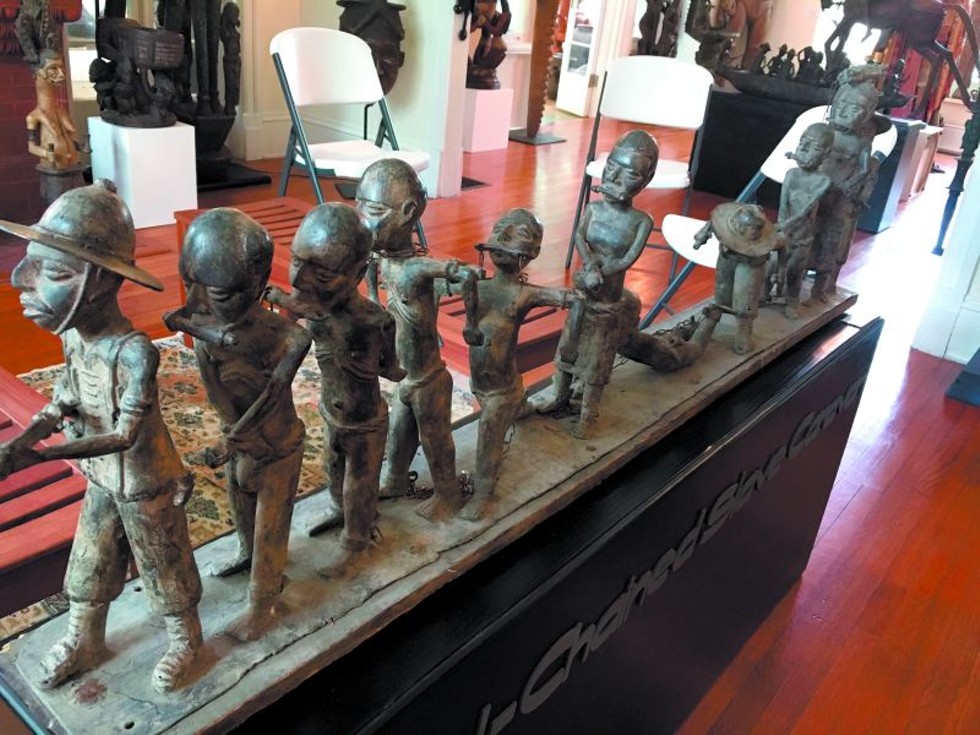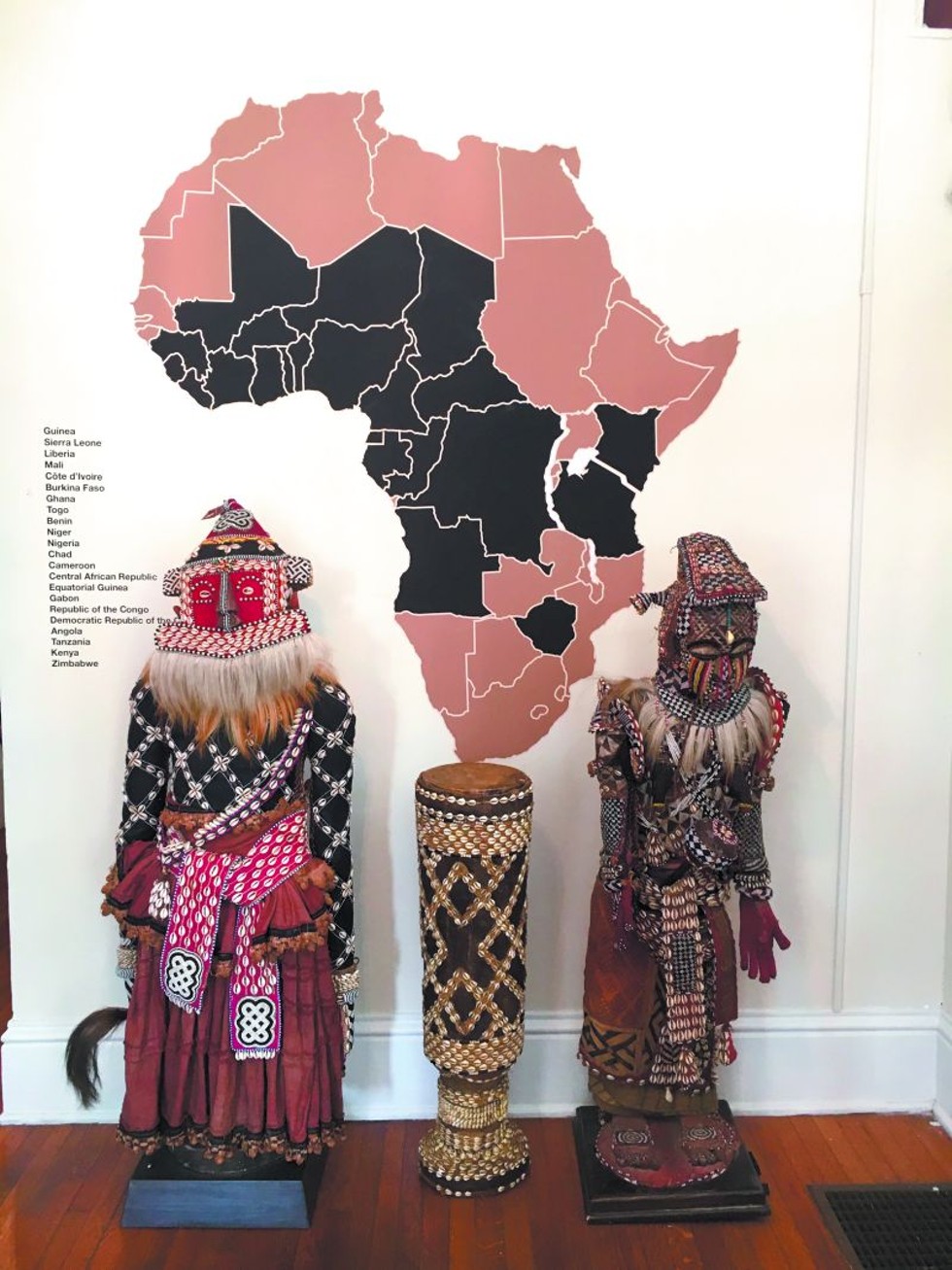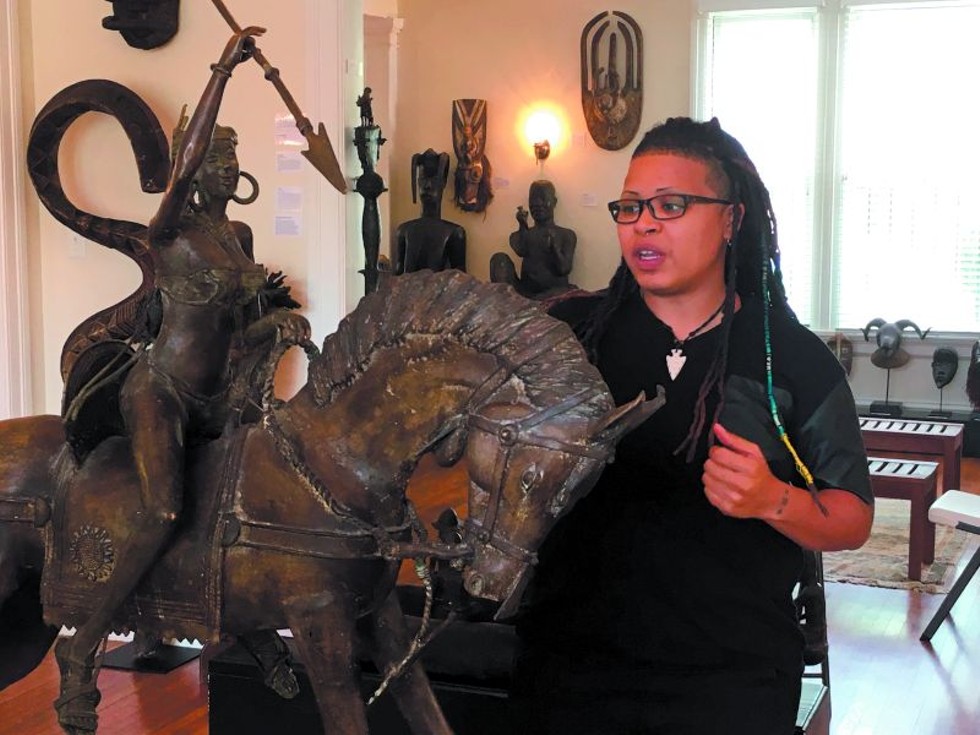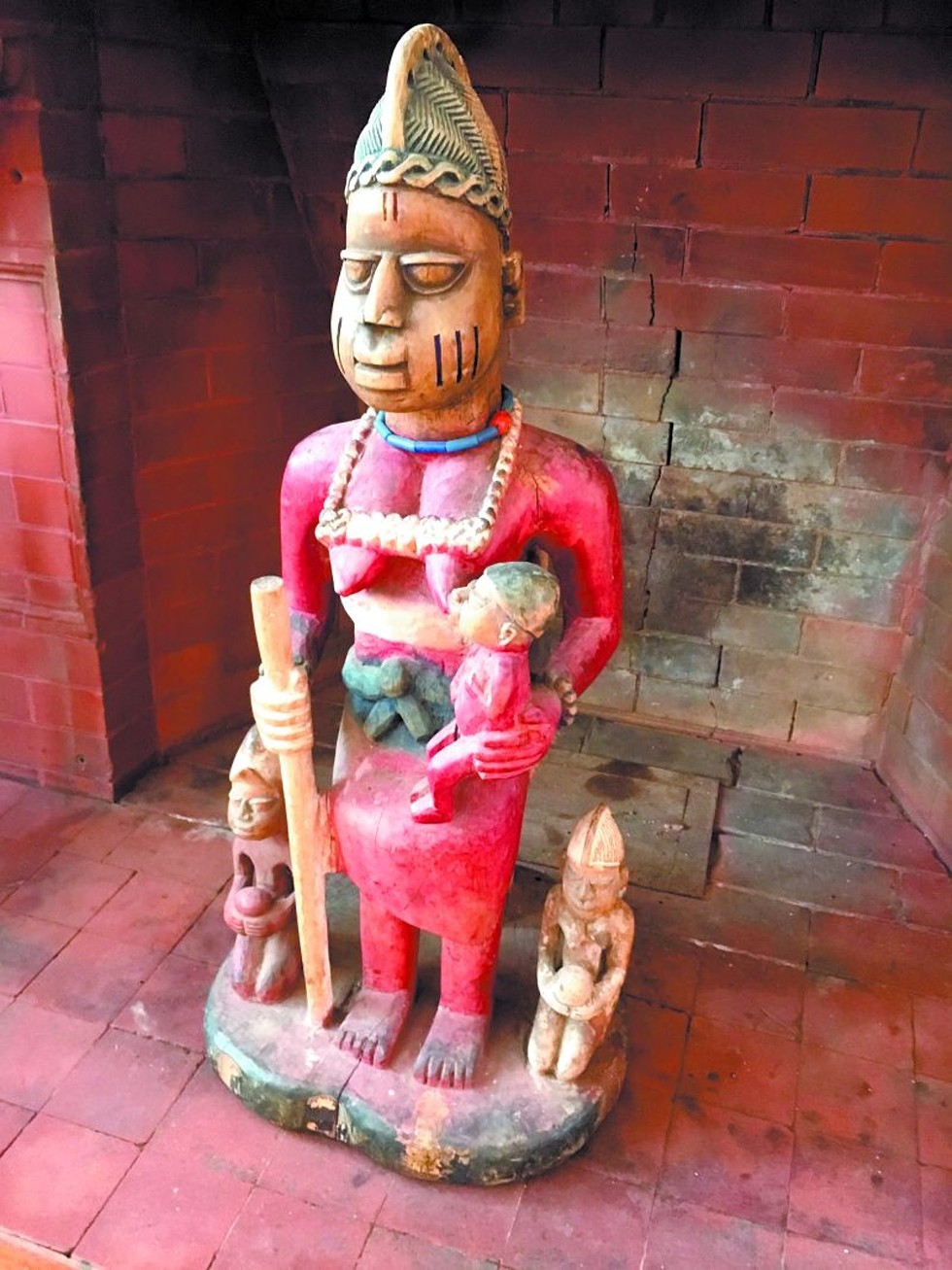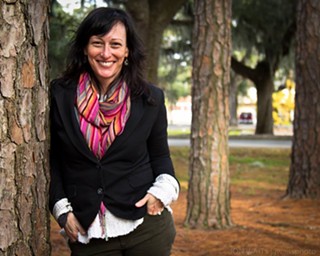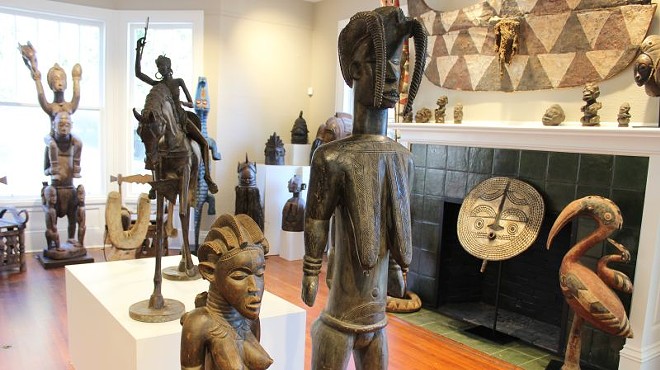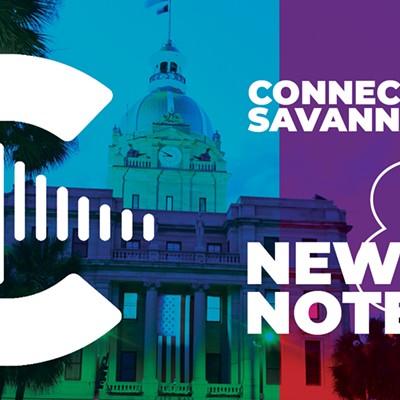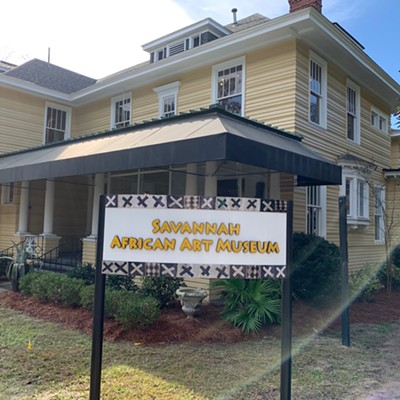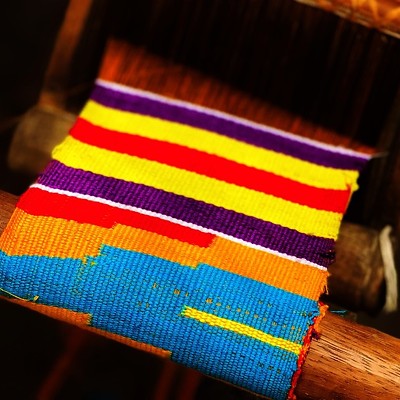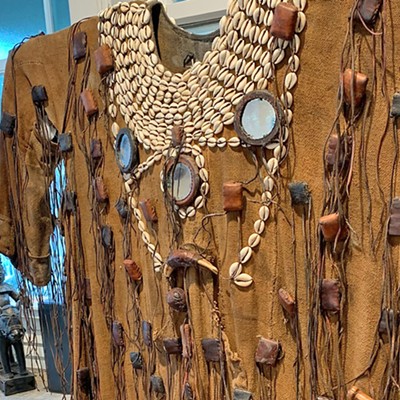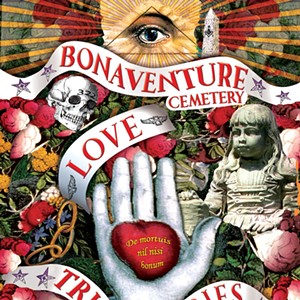IN THE TRANQUIL Thomas Square neighborhood, the cream-colored, Spanish-style manse stands out among the historic Victorians. But what’s inside sets it apart even further—an entire continent apart, in fact.
The Savannah African Art Museum opened quietly a few months ago in this century-old former residence, its sunny rooms now filled with hand-forged bronze sculptures, ceremonial beaded masks and exquisitely carved wooden totems created by artisans in Ghana, Nigeria, Tanzania and 19 other African countries. Over a thousand artifacts representing 130 individual cultures offer a sense of Africa’s vast size and multi-layered history, providing new contexts and dispelling myths as soon as the front door opens.
Greeting visitors in the foyer are a pair of regal figures in the ceremonial costumes of the Kuba kingdom in what is now the Democratic Republic of the Congo, the dyed textiles covered in the ubiquitous small, white cowrie shells associated with African art.
“We see a lot of cowrie shells, and they were historically used for trade and currency,” explains the museum’s curator, Billie Stultz. “What’s really interesting is that cowrie shells aren’t indigenous to Africa—they’re from the Indian Ocean.”
Before visitors move on to explore the rest of the house, they encounter the museum’s most important piece, front and center in the living room: A metal sculpture from the Kingdom of Benin in Nigeria depicting a line of soldiers leading captors in chains, some on their knees, to slave ships bound for America.
“When we talk about African art in this country, in this city, we must acknowledge how Africans came here,” says Stultz.
“We want to address it first thing.”
From there opens a reintroduction to the traditions obscured by slavery and mainstream history, the artistry of the Yoruba, Dogon and other people represented amongst the masks, pots, shields and figurines lining the fireplace mantles and windowsills. A fine-featured bronze princess from Burkino Faso rears back on a horse; a king and his wives are carved into a single, massive piece of wood. The breadth of the collection is amplified when it is considered that all of it was collected over three decades by one person.
Local businessman and philanthropist Don Kole became fascinated with artisanship of Africa after a visit to the National Museum of African Art in Washington, DC more than 30 years ago. Always an avid art collector, he then shifted his passion almost exclusively to objects originating from the complicated continent, amassing a body of work brokered by trusted sources.
“The craftsmanship is just spectacular,” marvels Kole.
“They created without power tools, without electricity, by the light of a fire.”
Except for an exhibit of metal works at Armstrong State University in 2014, the collection—now consisting of thousands of items—has been stored at the Kole Management offices and not been on display to the public. But when the house across the street next door to the Masjid Jihad mosque became available, Kole felt it was the perfect location to showcase the artistic and cultural treasures with the community.
“I’ve always wanted to share this, especially with young people,” he says, sitting next his favorite wooden column that once held up the veranda of a Yoruba king's palace.
“I’ve done it slowly, because I wanted to do it right.”
To help curate and manage the space, he hired Stultz, who graduated from SCAD with a double degree in Art History and Museum Studies. She was already aware of the nuanced nature of the work and welcomed the opportunity to bring it to others.
“I started off being interested in Egyptian art, but once I began studying the art of Africa, I realized how deeply rooted it is, and how it has influenced everything else,” says Stultz, citing Pablo Picasso and Henri Matisse.
“You can’t really talk about art without coming back to Africa.”
She estimates the museum contains around sixty percent of the entire collection, which is constantly being rotated as new pieces come in. Arranged currently by function—i.e., bowls with bowls, statues with statues—the art will soon be grouped by geographical origin to give visitors a more complete picture of where, when and why it was created.
One context the museum’s coordinators hope to resolve is that African art is merely decorative and rarely without higher intentions.
“Everything here had a purpose in the community, usually a spiritual one, involving protection or honoring the ancestors,” Stultz clarifies, pointing to an Egungun masquerade, a full-body costume employed by the Yoruba people to connect with departed loved ones, and a life-sized icon called a Nkisi Nkondi by the Congolese people that is covered in nails and contains medicinal herbs packed into its stomach and a pouch on its back.
“The act of creating was seen as an act of spiritual worship. There was no separation of artistry and spirituality.”
A partnership with the public schools is planned for the fall, and to help with the increased audience the museum recently hired curatorial assistant and registrar Rafaela Johnson. A world traveler with a background in art therapy and youth programming, Johnson is excited about the prospect of working with students who may know very little about Africa.
“As an African American, I find this so important because it draws the connection of ‘this is who we were before slavery, this is who we were before the colonists came.’ We were an advanced people,” she avows.
“We aren’t really taught that in school. It’s empowering.”
Admission to the Savannah African Art Museum is free, and the organization is seeking docents to train for operating hours, currently 11am-4pm, Thursday through Saturday.
In the meantime, Kole continues to add to the collection, seeking out pieces that have worldwide relevance, especially the work of renowned Yoruba carver Owole of Ise.
“These artistic traditions go back thousands of years, but people don’t realize it,” says the museum founder.
“I want it to bring pride to people’s hearts.”

